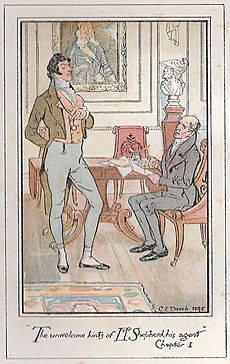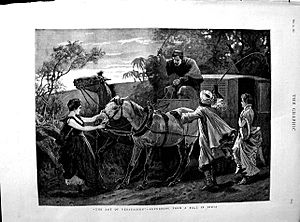Persuasion facts for kids

Persuasion is a way of influencing others. It means getting people to agree with an idea, a way of thinking, or an action. This is done using good reasons and feelings, not by force. Think of it as a way to solve problems by making a strong case, rather than by making someone do something.
Dissuasion is the opposite. It's when you try to convince someone not to believe or do something.
Sometimes, persuasion can be confused with manipulation. Manipulation is when someone tries to get you to agree to something that isn't good for you. True persuasion, however, aims to benefit everyone involved in the end.
Contents
Understanding Persuasion
Persuasion is a skill that helps you communicate effectively. It's about presenting your ideas clearly and convincingly. This can help you achieve goals, solve problems, and work better with others.
Why Persuasion Matters
Persuasion is important in many parts of life. It helps you:
- Share your ideas and get others to understand them.
- Work together with friends, family, or classmates.
- Make decisions that benefit everyone.
- Understand different points of view.
How People Persuade Others
There are many ways people try to persuade others. These methods often use a mix of facts, feelings, and good communication.
Using Facts and Logic
- Evidence: This means using facts, data, or examples to support your point. For instance, showing statistics about recycling can persuade people to recycle more.
- Logic: This is about using clear, step-by-step reasoning. You build an argument where each step makes sense, leading to a logical conclusion.
Using Communication Skills
- Rhetoric: This is the art of speaking or writing effectively. It involves choosing the right words and ways to present your message to make it more convincing.
- Presentation and Imagination: How you present your ideas matters. A clear, interesting presentation can help people imagine your idea and see its benefits.
- Body Language: Your non-verbal cues, like eye contact or posture, can also help persuade. Confident body language can make your message seem more believable.
- Communication Skill: Being a good listener and speaker helps. Understanding others' concerns allows you to address them in your argument.
Other Ways to Persuade
- Advertising: Companies use ads to persuade you to buy their products. They often highlight benefits or create an emotional connection.
- Propaganda: This is information, often biased or misleading, used to promote a political cause or point of view. It aims to persuade a large group of people.
- Tradition: Sometimes, people are persuaded by what has always been done. Following customs or long-held beliefs can be a strong form of influence.
- Faith: For some, belief in a higher power or a set of spiritual principles can be a powerful persuader for their actions and choices.
Less Common Techniques
Some techniques are less common or more complex:
- Hypnosis: This involves putting someone into a relaxed, focused state where they might be more open to suggestions. Its effectiveness in persuasion is debated.
Coercive Techniques
Some methods are not true persuasion because they involve force or trickery.
- Brainwashing: This is a harsh way of trying to change someone's beliefs or actions completely. It often involves intense pressure and isolation. These methods are very controversial and not scientifically proven to be effective in the long term.
See also
 In Spanish: Persuasión para niños
In Spanish: Persuasión para niños


